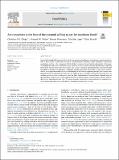| dc.contributor.author | Christine GK Chege, Kenneth W Sibiko, Rosina Wanyama, Matthias Jager, Eliud Birachi | |
| dc.date.accessioned | 2022-01-22T11:46:29Z | |
| dc.date.available | 2022-01-22T11:46:29Z | |
| dc.date.issued | 2019 | |
| dc.identifier.uri | https://repository.maseno.ac.ke/handle/123456789/4524 | |
| dc.description.abstract | Base of the Pyramid (BoP) consumers living in the urban informal settlements of developing countries spend over
60% of their income on food, yet malnutrition and micronutrient deficiency remain widespread among these
populations, pointing to the inadequacy of the foods they consume in terms of quality and quantity. In this paper
we examine BoP consumers’ willingness to pay (WTP) for nutritious multi-composite porridge flour (improved
flour) in the informal settlements of East Africa. The analysis is based on experimental data collected from 600
households in the informal settlements of Kampala, Uganda and Nairobi, Kenya (300 in each country) in 2016.
We use Tobit regression models to analyse determinants of WTP for the improved porridge flour. Results show
that both Kenyan and Ugandan BoP consumers are willing to pay a premium for the improved porridge flour. In
addition, providing nutrition information about the flour, characteristics of household head, economic status of
the household, and presence of young children between six and 59 months in the household, influence WTP for
the safe and nutritious porridge flour. The paper concludes by providing recommendations for enhancing nutrition among poor consumers in the informal settlements of developing countries. | en_US |
| dc.publisher | Pergamon | en_US |
| dc.subject | Willingness to pay Experimental auctions Consumers Informal settlements Nutritious foods Afric | en_US |
| dc.title | Are consumers at the base of the pyramid willing to pay for nutritious foods? | en_US |
| dc.type | Article | en_US |

